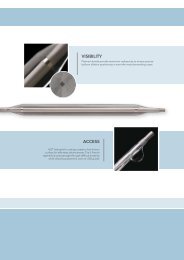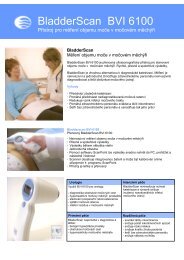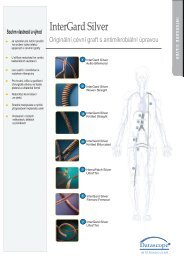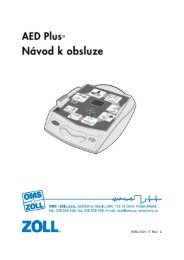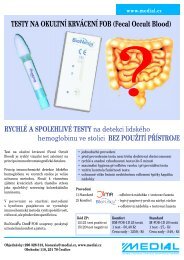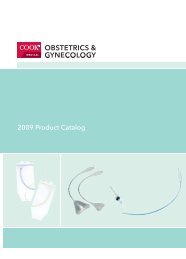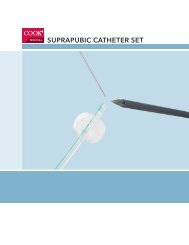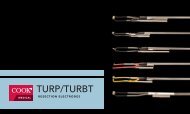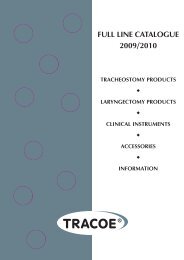The BAP test and the global assessment of oxidative stress ... - Medial
The BAP test and the global assessment of oxidative stress ... - Medial
The BAP test and the global assessment of oxidative stress ... - Medial
You also want an ePaper? Increase the reach of your titles
YUMPU automatically turns print PDFs into web optimized ePapers that Google loves.
to ferrous ions thus making uncolored <strong>the</strong>initial red solution. Such a chromatic change –may be due to <strong>the</strong> release <strong>of</strong> ferrous ions by<strong>the</strong> colored thiocyanate complex – can be readby means <strong>of</strong> a photometer, previously set at<strong>the</strong> wavelength <strong>of</strong> chromogen.<strong>The</strong>refore, <strong>the</strong> entity <strong>of</strong> absorbance changewill directly correlate with <strong>the</strong> antioxidant“potential” <strong>of</strong> blood plasma against <strong>the</strong> specificsubstrate which has been used asoxidant/detector (ferric ions). In o<strong>the</strong>r words,<strong>the</strong> ability <strong>of</strong> <strong>the</strong> <strong>test</strong>ed plasma to reduce ferricto ferrous ions may provide a direct measure<strong>of</strong> <strong>the</strong> ability <strong>of</strong> a sample <strong>of</strong> such plasma togive reducing equivalents <strong>and</strong> <strong>the</strong>n neutralizechemical species lacking <strong>of</strong> electrons, like ROS– obviously in <strong>the</strong> reduction-oxidation potentialrange <strong>of</strong> chosen oxidant-reducing couple(Fe 3+ /Fe 2+ ).On <strong>the</strong> basis <strong>of</strong> this background, a novel<strong>test</strong>, aimed to assess <strong>the</strong> antioxidant plasmaactivity, has been recently developed by <strong>the</strong>Italian Chemist Mauro Carratelli <strong>and</strong> firstdescribed by Dohi et al. (20).This <strong>test</strong> has been called “<strong>BAP</strong>” <strong>test</strong> whichinitials underline that <strong>the</strong> assay is designed toassess <strong>the</strong> Biological Antioxidant Potential <strong>of</strong>blood plasma.<strong>The</strong> aim <strong>of</strong> this short review is to present<strong>the</strong> principle, <strong>the</strong> validation, <strong>the</strong> procedure, <strong>the</strong>indications <strong>and</strong> clinical usefulness <strong>of</strong> <strong>the</strong> <strong>BAP</strong><strong>test</strong> in <strong>the</strong> light <strong>of</strong> <strong>the</strong> available literature.2. Principle<strong>BAP</strong> <strong>test</strong> is based on <strong>the</strong> ability <strong>of</strong> a coloredsolution, containing a source <strong>of</strong> ferric (Fe 3+ )ions adequately bound to a specialchromogenic substrate, to decolour when Fe 3+ions are reduced to ferrous ions (Fe 2+ ), as itoccurs by adding a reducing/anti-oxidantsystem, i. e. a blood plasma sample (20).<strong>The</strong>refore, in <strong>the</strong> <strong>BAP</strong> <strong>test</strong>, a small amount<strong>of</strong> blood plasma (10 µL) to be <strong>test</strong>ed isdissolved in a colored solution, which has beenpreviously obtained by mixing a source <strong>of</strong>ferric ions (i. e. ferric chloride, FeCl 3 , <strong>the</strong> R 2reagent) with a special chromogenic substrate(i. e. a thiocyanate derivative, <strong>the</strong> R 1 reagent)(19).After a short incubation (5 min), at 37 °C,such solution will decolor <strong>and</strong> <strong>the</strong> intensity <strong>of</strong>this chromatic change will be directlyproportional to <strong>the</strong> ability <strong>of</strong> plasma to reduce,during <strong>the</strong> incubation, ferric ions (initiallyresponsible for <strong>the</strong> color <strong>of</strong> solution) to ferrousions, according to <strong>the</strong>se reactions:1. FeCl 3 + AT (uncolored) → FeCl 3 – AT (colored)2. FeCl 3 –AT (colored) + BP (e-) → FeCl 2 + AT (uncolored) + BPwhere:• FeCl 3 is ferric chloride;• AT (uncolored) is a thiocyanate derivative (uncolored);• FeCl 3 – AT (colored) is <strong>the</strong> colored complex <strong>of</strong> ferricchloride with <strong>the</strong> thiocyanate derivative;• BP (e-) is a molecule <strong>of</strong> blood plasma barrier withreducing/electron giving/antioxidant activityagainst ferric ions;• BP is <strong>the</strong> oxidized form <strong>of</strong> BP (e-) ;• FeCl 2 is <strong>the</strong> ferrous chloride obtained by <strong>the</strong>reducing activity <strong>of</strong> BP (e-) .By assessing photometrically <strong>the</strong> intensity<strong>of</strong> decoloration, <strong>the</strong> amount <strong>of</strong> reduced ferricions can be adequately evaluated thus allowingan effective measurement <strong>of</strong> reducing ability orantioxidant potential <strong>of</strong> <strong>test</strong>ed blood plasma(20).Such a “potential” is obviously not absolutebut relative to <strong>the</strong> <strong>test</strong>ed substrate, i. e. ferricions. Considering that such ions are naturallyoccurring components <strong>of</strong> <strong>the</strong> body, <strong>BAP</strong> <strong>test</strong>,as its initials suggest (Biological AntioxidantPotential), provides a reliable measure <strong>of</strong>antioxidant power <strong>of</strong> <strong>the</strong> fraction <strong>of</strong> plasmabarrier to oxidation which is directly involved –due to <strong>the</strong> implicated reducing-oxidantpotentials – against <strong>the</strong> attack <strong>of</strong> reactivechemical species in “physiological” or“biological” conditions.However, since <strong>the</strong> main aim <strong>of</strong> <strong>BAP</strong> <strong>test</strong> isto provide a <strong>global</strong> <strong>assessment</strong> <strong>of</strong> antioxidantdefenses <strong>of</strong> our body, no studies has beenperformed in order to establish <strong>the</strong> exactcontribution to <strong>the</strong> assay <strong>of</strong> eachserum/plasma blood antioxidants, whichamount should be detected by means <strong>of</strong>6www.fras4evolvo.it



